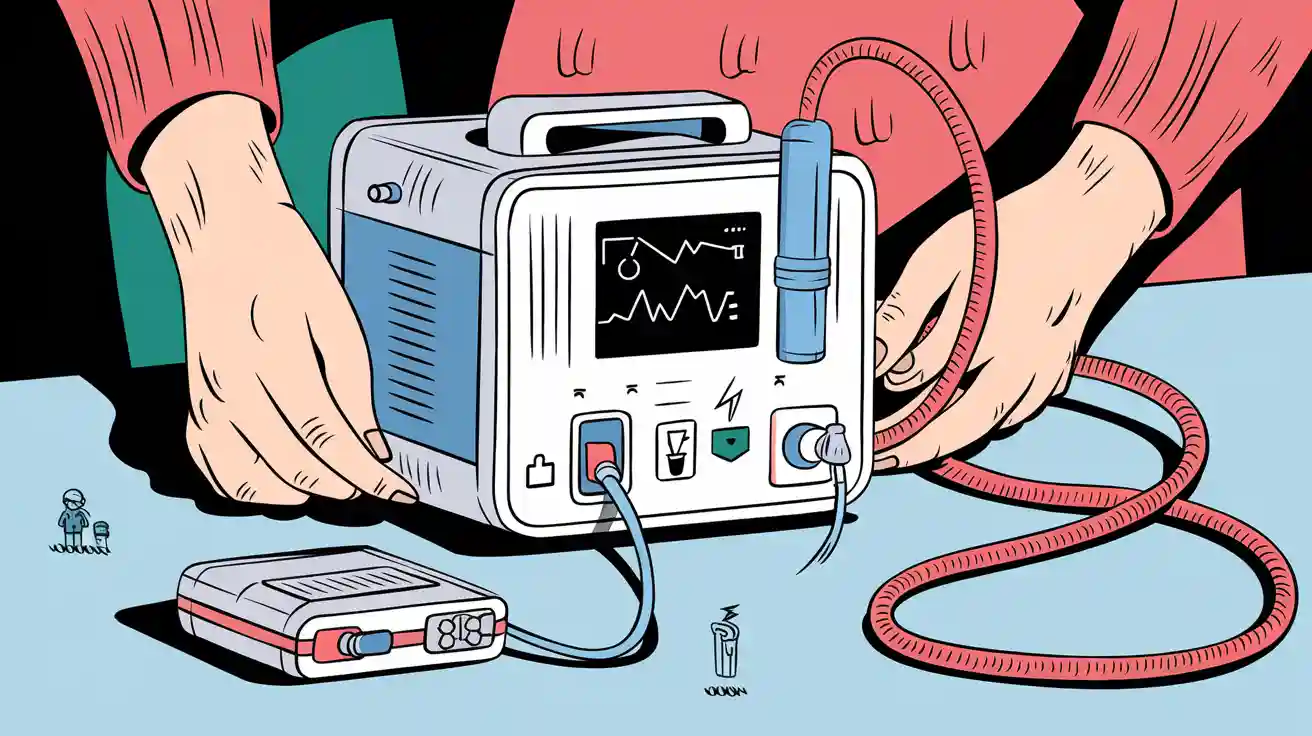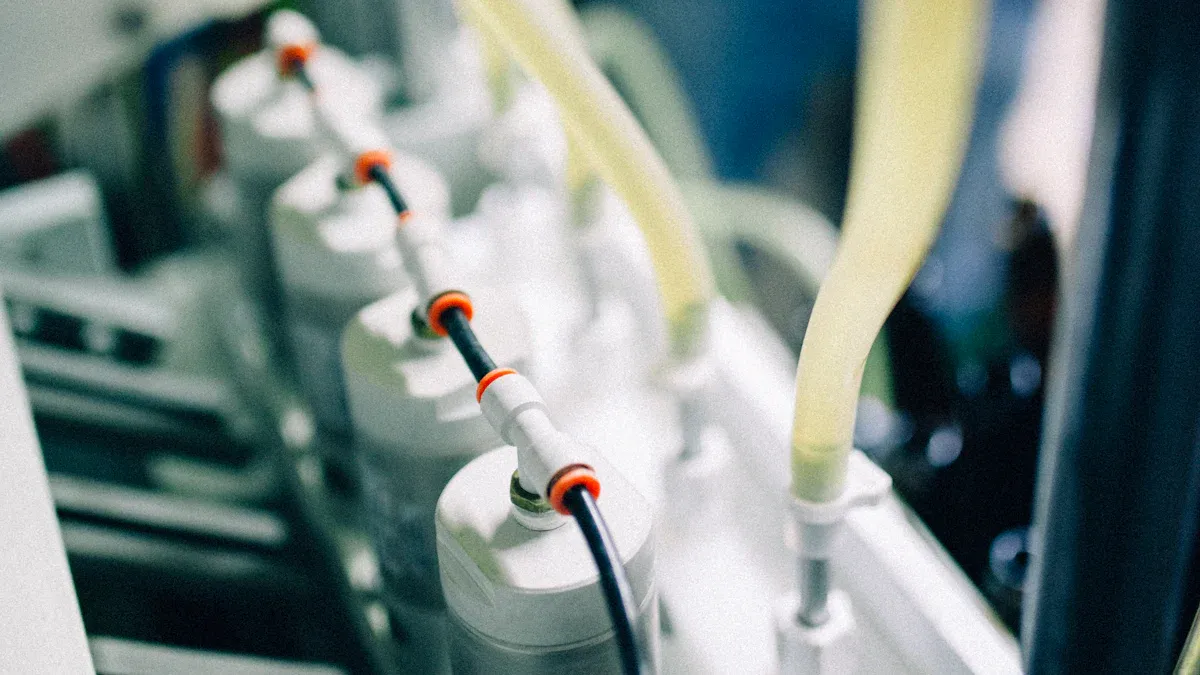
You rely on battery solutions that deliver consistent power for every portable ventilator in your facility. Lithium-ion and lithium polymer stand out as reliable solutions, while sealed lead acid remains a traditional choice for critical equipment. Patient safety depends on strict international battery standards, such as IEC 62133 and UL 1642/2054:
Battery Type | Relevant Standard |
|---|---|
Rechargeable batteries | IEC 62133 |
Non-rechargeable lithium batteries | IEC 60086-4 |
Devices sold in North America | UL 1642/2054 |
Hot-swappable battery packs help you maintain uninterrupted life-saving technology for ventilators in portable settings.
Key Takeaways
Choose lithium-ion and lithium polymer batteries for portable ventilators. They offer high energy density, long cycle life, and low maintenance, ensuring reliable performance.
Always verify battery compliance with safety standards like IEC 62133 and UL 1642/2054. This step is crucial for patient safety and device reliability.
Utilize hot-swappable battery packs. This feature allows for uninterrupted operation during battery changes, enhancing care in clinical and emergency situations.
Part 1: Battery Solutions Overview

1.1 Lithium-Ion and Lithium Polymer
You need battery solutions that deliver high energy density, long cycle life, and robust safety features for every portable ventilator. Lithium-ion and lithium polymer batteries have become the industry standard for medical, robotics, and security systems due to their lightweight design and reliable performance. These chemistries, including NMC (Nickel Manganese Cobalt), LCO (Lithium Cobalt Oxide), and solid-state lithium polymer, offer significant advantages for ventilators.
Feature | Lithium-Ion | Lithium Polymer |
|---|---|---|
Energy Density | 150-250 Wh/kg | 300-400 Wh/kg |
Cycle Life | 500-1000 cycles | 1500-2000 cycles |
Safety Features | Lower safety due to liquid electrolyte | Higher safety with solid-state electrolyte |
You benefit from the high energy density of lithium polymer batteries, which allows for compact, long-lasting batteries that keep ventilators running for extended periods. Lithium-ion batteries provide a balance between cost and performance, making them suitable for both medical and industrial applications. Both types support detachable, hot-swappable battery packs, ensuring continuous operation during battery replacement or charging.
Note: Lithium battery packs must comply with strict safety standards. You should always verify certifications such as IEC 62133 and UL 1642/2054 before integrating these solutions into your devices. For more on battery safety standards, see UL Standards.
Despite their advantages, lithium-based batteries can present safety risks. Common failure modes include:
Thermal runaway
Fires
Leaks
Off-gassing
Explosions
In recent years, incidents involving thermal runaway and fires have led to recalls and safety warnings from regulatory agencies. For example, in 2023, the FDA recalled a glucose monitoring system due to fire risks, and in 2022, a battery explosion in a medical device resulted in fatalities. These events highlight the importance of rigorous quality control and proper battery management in medical environments (FDA Safety Communications).
1.2 Sealed Lead Acid
Sealed lead acid batteries remain a traditional choice for ventilators, especially in emergency and backup scenarios. You may encounter these batteries in legacy systems or where cost constraints exist. However, you should consider their limitations compared to lithium-based solutions.
Aspect | Lead-Acid Batteries | Lithium-Ion Batteries |
|---|---|---|
Cycle Life | 500–1,000 cycles | 2,000–3,000+ cycles |
Years of Service | 3–5 years | 8–10 years |
Maintenance Needs | High | Low |
Cost Over Time | Higher | Lower |
Use Cases | Limitations |
|---|---|
Emergency situations | Overheating in tightly enclosed surroundings can lead to disastrous outcomes. |
Applications requiring reliability | Hydrogen gas buildup poses an explosion hazard if adequate ventilation is not provided. |
Medical ventilators | Must consider battery integration and performance characteristics for safe operation in devices. |
You may find sealed lead acid batteries in infrastructure and industrial applications where reliability is critical. However, these batteries require regular maintenance and proper ventilation to prevent overheating and hydrogen gas buildup. Their shorter lifespan and higher total cost make them less attractive for modern portable ventilator designs.
1.3 NiMH Options
Nickel-metal hydride (NiMH) batteries offer a middle ground between sealed lead acid and lithium-based solutions. You can use NiMH batteries in medical, consumer electronics, and industrial sectors where moderate energy density and cost-effectiveness are priorities.
Battery Type | Energy Density (Wh/l) | Recharge Cycles |
|---|---|---|
NiMH | 160-420 | 500-1000 |
Lithium-Ion | Higher than NiMH | Often exceeds 1000 |
Sealed Lead Acid | Lower than NiMH | Fewer than NiMH |
NiMH batteries store 2-3 times more energy than lead-acid batteries for the same weight.
They have a cycle life of 500-1000 cycles, which is competitive but less than lithium-ion.
NiMH batteries can deliver a power density of over 800 W/kg, suitable for high-power applications.
Advantages | Disadvantages |
|---|---|
Cost-effective | Vulnerable to memory effect (voltage depression) |
Tolerant to extreme temperatures | Higher self-discharge rates, impacting long-term reliability |
Less prone to safety risks like thermal runaway | Shorter service life under heavy load conditions |
You may choose NiMH batteries for ventilators that require moderate runtime and operate in environments with temperature extremes. However, you should be aware of their higher self-discharge rates and susceptibility to the memory effect, which can reduce long-term reliability.
Tip: Always select battery solutions that support detachable, hot-swappable packs. This feature ensures uninterrupted care and simplifies maintenance for your portable ventilator fleet.
For more information on battery chemistries and their environmental impact, see our Sustainability Statement and Conflict Minerals Policy.
Part 2: Key Features for Portable Ventilator Batteries
2.1 Capacity and Runtime
You must evaluate battery capacity and runtime to ensure your portable ventilator delivers reliable performance in clinical settings. Most ventilators require about 15W at 5L/min airflow. A 3.7V / 6000mAh lithium polymer cell can provide up to 8 hours of runtime. For continuous 24-hour operation, you can connect multiple battery packs in parallel. Long-lasting batteries support uninterrupted care and reduce the risk of power loss during transport or emergencies.
Typical ventilator power demand: 15W at 5L/min airflow
3.7V / 6000mAh Li-Po cell: ~8 hours runtime
Multiple packs: 24-hour continuous operation
Device weight: under 1.5 kg
Ventilator Model | Drive System | Battery Type | Battery Duration |
|---|---|---|---|
LTV 1200 | Constant-speed | Lead-acid | Shortest |
T1 | Variable-speed | Lithium | Moderate |
EMV | Piston-driven | Lithium | Longest |
HT70 | Piston-driven | Integrated Lithium | Extended (30 min after main battery) |
2.2 Weight and Portability
You need high-performance batteries that keep your devices lightweight and easy to transport. Lithium battery chemistries such as NMC and LCO offer energy densities of ≥220 Wh/kg, supporting compact designs. In medical, robotics, and security systems, weight and portability are critical for rapid deployment and patient mobility. Devices under 1.5 kg allow for easy handling in clinical and emergency scenarios.
2.3 Charging and Hot-Swap
You should prioritize batteries with hot-swappable and detachable packs. This feature enables you to replace batteries without interrupting ventilator operation. In infrastructure and industrial applications, hot-swap capability ensures continuous workflow and minimizes downtime. Fast charging and parallel pack connection further enhance operational efficiency. For advanced battery management, consider integrating a battery management system to monitor charging cycles and optimize battery tests.
Tip: Regular battery tests help you identify weak cells and prevent premature discharge.
2.4 Safety and Compliance
You must select batteries that meet strict safety and compliance standards. Common incidents include failure to run on battery power and premature discharge. These issues can compromise patient safety and device reliability. Leading standards include IEC 62133, UN38.3, and SASO-IEC-62281:2018. Compliance with these standards ensures your batteries pass rigorous battery test solution protocols and meet regulatory requirements.
Requirements | Compliant Standards |
|---|---|
Batteries safety | SASO-IEC-60086-4:2007, SASO-IEC-62281:2018, SASO-IEC-62133-1:2017 |
IEC 62133 and UN38.3 are essential for lithium battery packs in medical, consumer electronics, and industrial sectors.
Battery tests should verify cycle life, energy density, and safety features for every batch.
Part 3: Maximizing Battery Performance and Safety
3.1 Charging Best Practices
You can extend the lifespan of your battery by following proven charging routines. Always use the original charger to prevent overcharging and damage. Charge when the power drops to 20% and stop at 90% to avoid long-term full charge. Shallow charging and shallow discharge help maintain battery health. Avoid exposing batteries to extreme temperatures, as high heat accelerates aging and cold can cause sudden drops in capacity. Overcharging or using poor-quality chargers may lead to overheating, which is a leading cause of battery failure in medical and industrial environments.
Tip: Never allow batteries to fully discharge. Regular deep discharges shorten their service life and increase safety risks.
3.2 Storage and Maintenance
Proper storage and maintenance routines keep your batteries ready for use. Store batteries in a cool, dry place between 20°C and 25°C, away from direct sunlight and moisture. Use silica gel packs to control humidity and ensure good ventilation to prevent heat buildup. For long-term storage, charge batteries to 50% and disconnect them from devices. Recharge to 50% every three months. When handling batteries, wear gloves and eye protection, check connections, and clean terminals to prevent corrosion.
3.3 Quality Testing
You need reliable testing to ensure battery safety and performance. Automated battery analyzers, such as BatteryFlex, use advanced diagnostics like Electrochemical Impedance Spectroscopy (EIS) to monitor battery health. These platforms support environmental, abuse, and life-cycle testing, as well as state-of-charge and state-of-health verification. Automation reduces errors and speeds up maintenance for large battery fleets in medical, robotics, and security systems. Regular safety checks and monitoring help you detect faults early and maintain compliance with industry standards.
Part 4: Backup Power for Ventilators

4.1 External Battery Packs
You need reliable backup power to keep your ventilator running during outages or transport. External battery packs offer a flexible solution for both hospital and field environments. Mobile energy systems provide immediate and temporary backup wherever you need it. You can mount these systems on trailers, store them in compact boxes, or use them in rugged, weatherproof enclosures. Most external packs use lithium-ion or AGM batteries, which deliver high energy density and long cycle life. Smart monitoring systems help you track battery status and ensure efficient operation.
Feature | Description |
|---|---|
Mobile Energy Systems | Provide immediate, temporary backup power wherever needed. |
Configuration Flexibility | Mount on trailers, store in containers, or use compact boxes. |
Battery Types | Use lithium-ion or AGM battery packs. |
Charging Compatibility | Integrate solar or generator charging options. |
Monitoring Systems | Include smart monitoring for efficiency. |
Durability | Built with rugged, weatherproof enclosures. |
You can also use power generators and uninterruptable power supply (UPS) units as backup. Generators provide long-term energy during extended outages. UPS units stabilize power and act as a bridge when the main source fails.
4.2 Solar and Alternative Charging
Solar charging solutions address unique challenges in field hospitals and emergency stations. You can use solar power systems to provide clean, stable backup power that meets hospital-grade standards. These systems ensure safe and reliable operation for your ventilators. Some portable turbine-based ventilators can run on solar power and feature replaceable batteries. They can operate for 5 to 6 hours without a main power connection.
Alternative charging methods include using inverters from vehicle batteries or 12V DC from a cigarette lighter. However, these options have limitations. Vehicle-based charging requires compatible setups, and 12V DC charging is only available in certain vehicles. Battery types like NiCd, NiMH, and lithium-ion offer limited charge capacity and can be cumbersome for frequent backup use.
Charging Method | Limitations |
|---|---|
Battery types (NiCd, NiMH, Li-ion) | Limited charge capacity, can be cumbersome |
Inverters from vehicle batteries | Requires compatible vehicle and setup |
12 V DC from cigarette lighter | Limited to vehicles with this feature available |
4.3 Power Management
Effective power management strategies help you maintain continuous backup for your ventilator fleet. Many ICU ventilators lack built-in power supplies, so you must ensure a continuous source during patient transport. Portable battery solutions like the 3M SARNS HELP 115 provide uninterrupted backup power, supporting critical care during transfers.
You should use new generation lithium batteries for long-lasting backup. Track and maintain your equipment regularly. Keep devices charged and connect transport equipment to wall sockets as soon as possible. Set alarms for weak battery life to prevent unexpected failures. Surge ventilators with flexible power requirements and disconnect alarms improve emergency preparedness.
Tip: Always keep backup batteries ready and test them frequently to ensure reliable operation during emergencies.
You gain clear advantages by choosing lithium-ion and lithium polymer batteries for your portable ventilator fleet.
These batteries deliver higher energy density, longer cycle life, and require less maintenance than sealed lead acid or NiMH options.
Non-toxic, non-vented lithium batteries enhance safety in medical and industrial environments.
Backup power systems operate silently, reduce fire risks, and keep essential equipment running during outages.
Evaluate compatibility, hot-swappable features, and quality assurance to ensure reliable, uninterrupted care.
FAQ
What lithium battery chemistries work best for portable ventilators?
You get the best results with NMC, LCO, and solid-state lithium polymer batteries. These chemistries offer high energy density, long cycle life, and strong safety features for medical devices.
How do you ensure lithium battery packs meet medical safety standards?
You should verify compliance with IEC 62133, UL 1642/2054, and UN38.3. Always request certification documents from your supplier before integrating lithium battery packs into ventilator systems. Consult Large Power for more medical battery solutions.
Can you hot-swap lithium battery packs during ventilator operation?
Yes. Most modern lithium battery packs support hot-swapping. This feature lets you replace batteries without interrupting ventilator function, ensuring continuous patient care in clinical and emergency settings.




